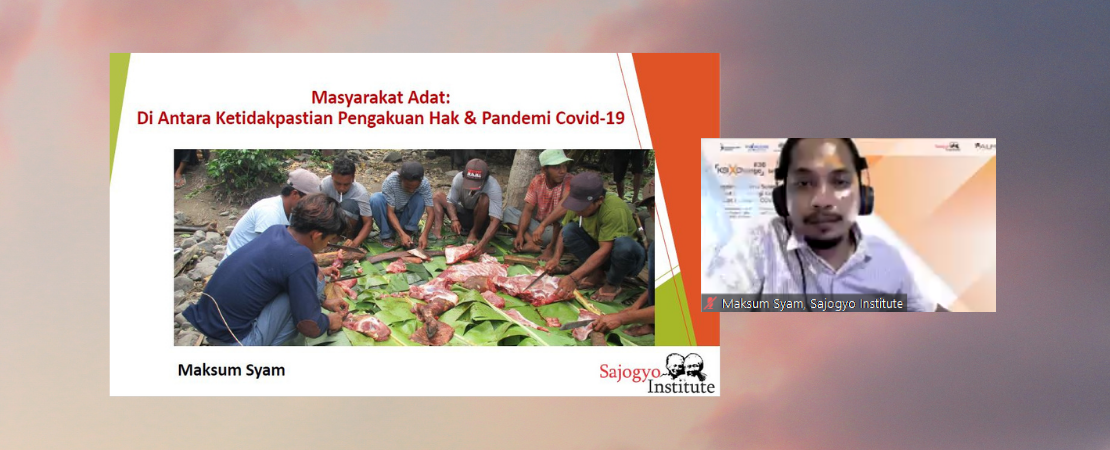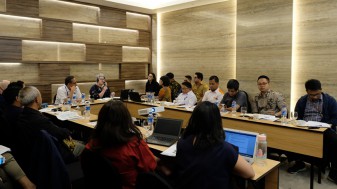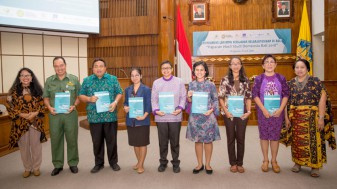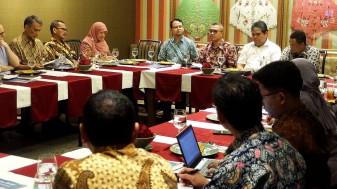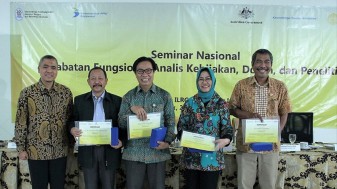Indigenous people are often seen as vulnerable due to their lifestyles differing from modern customs. This vulnerability comes from various policies being detrimental to indigenous people. It accumulates when legal products, policies and programs approved during the pandemic are not developed in the spirit of protecting indigenous people.
This theory was presented by Maksum Syam, the Director of Sajogyo Institute, at the KSIxChange#36 event: ALMI Special Scientist Series, on Tuesday 21 September. The forum, ‘How Social and Humanities Science Can Protect Vulnerable Groups from the Impact of the COVID-19 Pandemic’, was held by the Knowledge Sector Initiative (KSI), in collaboration with the Indonesian Young Academy of Science (ALMI).
Speakers presented the situation of vulnerable groups in Indonesia. In addition to Maksum, other speakers included an education researcher of the State University of Semarang (Universitas Negeri Semarang), Zulfa Sakhiyya, an arts and culture researcher from the State University of Jakarta (Universitas Negeri Jakarta), Aprina Murwanti, a social, cultural and religious science researcher from the National Research and Innovation Agency (BRIN), Najib Burhani, an economic researcher from the University of Indonesia, Teguh Dartanto, and a health researcher from Hasannudin University (Universitas Hasannudin), Sudirman Nasir. Inaya Rakhmani and Evi Eliyanah from ALMI moderated the discussion. This event was broadcast on The Conversation Indonesia’s YouTube channel and was equipped with English and Bahasa Indonesia interpreters, as well as sign language interpreters.
Maksum emphasised that indigenous people have the same rights as other people, but up until now recognition of their existence has been limited to acknowledging their identity. “The recognition should be comprehensive, followed by a recognition of resources and living spaces, Maksum said. “Currently, the living spaces of indigenous people have not been recognised, thus causing a conflict with the state and private sector.”
Maksum said there were at least three main issues that made it difficult to receive recognition from the state regarding indigenous people’s living spaces and resources. These are overlapping land ownership claims; long and expensive requirements to obtain recognition; and unsynchronised regulations regarding the rights of indigenous people.
Overlapping regulations
Even though the existence of indigenous people has been guaranteed by the Law, overlapping land ownership claims continue to happen. This is because the priority to protect indigenous people often contradicts other priorities. Maksum gave an example of how indigenous people in Pandumaan Sipituhuta, North Sumatera, have found it difficult to obtain indigenous areas since the government established the Toba Lake National Strategic Tourism Area (KSPN).
“The community’s right to live is hindered by the state’s interest, priority and obsession with developing tourism areas as economic sources without looking at the sustainability aspect,” said Maksum.
In addition to the state, indigenous people must also face capital interest. This, for example, happens in Sorolangun, Jambi, where indigenous people called Orang Rimba are having difficulty obtaining areas due to a business use right (HGU) claim for a palm oil plantation.
Recognition of indigenous lands is not a swift process. “It needs a long time and high cost,” Maksum said.
In Central Sulawesi, for example, indigenous people needed up to IDR 700 million to receive recognition in the form of local regulation. This money was used for public consultation, lobbying and hearing processes, which took two years to complete.
When indigenous people are willing to apply for indigenous forest establishment through the proper channels, namely the Ministry of Environment and Forestry (KLHK) and the Ministry of Agrarian and Spatial Management/National Land Agency (ATR/BPN), the process is slow. This happened during the application to approve the Rejang Lebong indigenous forest, which was submitted to the government in 2018. There is still no news on this application.
The need for legal synchronisation
The issues facing indigenous people become even more complex with unsynchronised regulations regarding the rights of indigenous people. The Job Creation Law, which prioritises large-scale, area-based economic development and has the potential to threaten the living space of indigenous people, was swiftly ratified. Meanwhile, discussion of the Bill for the Indigenous Peoples’ Law is stagnating. “Ironically, these all happened during the years when the pandemic hit, when the government should have prioritised the living space rights of indigenous people,” Maksum said.
Maksum stated that the best solution possible to reduce the vulnerability of indigenous people would be to ratify the Bill on Indigenous People. Ratification of this Bill would ensure the synchronisation of various regulations hindering the acceleration of indigenous areas, and realise the order of Constitutional Court Number 35/2012 regarding Indigenous Forests. “In the end, this can eliminate conflicts within indigenous areas, both in forest areas and non-other use areas (non-APL),” explained Maksum.
This step needs to be followed up with other efforts, such as stopping licensing and businesses that can potentially create conflicts with indigenous people. The state also needs to pay attention to the forms of indigenous-based agrarian management.
Ultimately, Maksum said indigenous people, who are considered vulnerable, are actually a resilient group. Internally, they have a strong social capital. They also have a needs-fulfillment system that does not depend on market mechanisms. The way indigenous people manage their resources is proof that they are not significantly affected by national or global crises, including the pandemic. Their vulnerability surfaced due to detrimental policies. “Do not forget to fulfil their health rights during the pandemic, especially vaccination for indigenous people,” Maksum said in closing.

